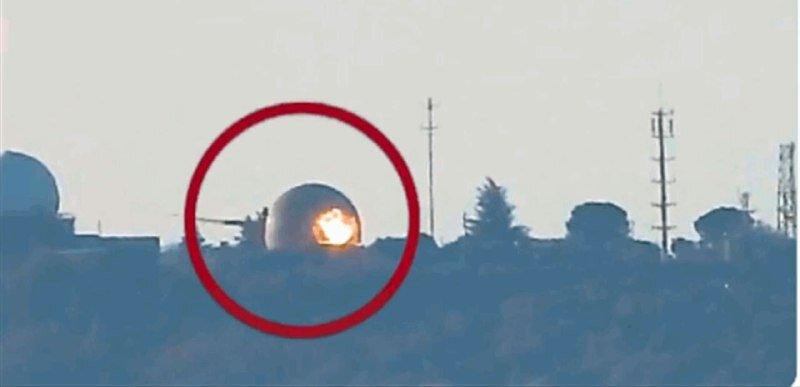Examining Hezbollah's attack on Meron

TEHRAN- The initial response by Hezbollah to the Israeli assassination of Hamas deputy leader Saleh al-Arouri in southern Beirut raises key points.
Israel’s Air Traffic Control Headquarters in northern occupied Palestinian territories goes much further than what the name entails.
It is the regime's aerial intelligence headquarters and command center, with observation posts, a drone field, radar systems, and other installations related to espionage and cyber warfare.
The complex is responsible for commanding, coordinating, and organizing all Israeli air attacks against Syria and Lebanon.
Experts point out that the Meron air base struck by Hezbollah was the same air base from where the regime commanded, oversaw and dispatched the drone that assassinated the Hamas deputy political leader Saleh Al-Arouri in the Lebanese capital Beirut.
It is 15 kilometers away from the Lebanese border and hosts top Israeli generals, elite units, and highly specialized officers.
THE RETALIATION
Hezbollah said on Saturday morning that it had fired at least 60 long-range precision guided missiles and rockets at the Meron air base.
The attack on one of the most strategic and sensitive sites left the Israeli regime in shock.
Reports indicate that the level of the bombardment by Hezbollah set off sirens in 94 Israeli settlements. Sirens were later also blaring in the Israeli-occupied Syrian Golan Heights.
The footage published by Hezbollah of the retaliatory operation shows plumes of black smoke, which means the Israeli Iron Dome system or Patriot batteries were unable to intercept the attack.
The Meron Air Traffic Control Headquarters sits atop Mount Jarmaq (Meron), which is considered the highest peak in occupied Palestine.
Experts say Grad rockets were used as part of two salvoes.
The heavy black plumes of smoke indicate that the complex was directly hit by vehicles and other structures left ablaze.
PRELIMINARY RESPONSE
Hezbollah described the operation as an "initial response".
Experts highlight that it would have been sufficient for the Lebanese resistance to say this was "the response" or "a response" to the assassination of al-Arouri.
Hezbollah wants to make it clear that this was the "preliminary" response, which means there will be a second response.
The possibility is that the "initial" response was retaliation for the assassination of al-Arouri.
The statement issued by Hezbollah alluded to this. "As part of the initial response to the crime of assassinating the great leader Sheikh Saleh al-Arouri … the Islamic resistance (Hezbollah) targeted the Meron air control base with 62 various types of missiles".
The second response could come (perhaps at a later time) to the flagrant Israeli violation of Lebanon’s sovereignty and territorial integrity.
INTELLIGENCE
The Israeli Meron air base is no secret facility to the resistance. There is a second air base in the northern Israeli-occupied Palestinian territories, but it does not carry the same capabilities that Meron possesses.
What has put Israeli media in a state of hysteria is that the retaliatory operation was conducted in broad daylight, at a time when drones were flying and landing at Meron.
This indicates the high degree of intelligence and prowess that Hezbollah has under its hands that it is able to target one of the most sensitive Israeli sites in clear daylight, bypassing all Israeli monitoring means.
In a speech, the Secretary-General of Hezbollah, Sayyed Hassan Nasrallah, announced the decision to respond, saying that staying silent would be more dangerous.
Before he made those remarks on Friday night, the operation went into effect on Saturday morning.
Hezbollah's "initial" retaliation can be attributed to the assassination of al-Arouri.
The operation by the Lebanese resistance is the complete opposite of the Israeli assassination of al-Arouri, which took place in the dark before sunrise.
Israeli media said targeting Meron was conducted with "a high degree, and it is worrying in terms of the amount of information Hezbollah has about very strategic places."
Hezbollah published a video showing how strategic the Meron air base is to the Israeli regime while describing all of its capabilities.
WHAT NEXT?
According to experts, if the regime wants to escalate its northern front beyond the roughly one dozen air raids it conducted in southern Lebanon following the Hezbollah attack on Meron, then the Lebanese resistance has the means to escalate the battlefield further by surprising the regime again.
Hezbollah considered that targeting a sensitive Israeli complex and causing a considerable level of destruction to it was bigger than killing several Israeli officers during the daily exchange of fire along the Lebanese-occupied Palestinian border.
It is conducting this already on the battlefield.
This was the "initial response". All eyes are now on Hezbollah's second response and how that will unfold.
Western diplomats are rushing to the region in a bid to lower the crisis in Gaza from spiraling into an all-out war between Hezbollah and the Israeli occupation.
